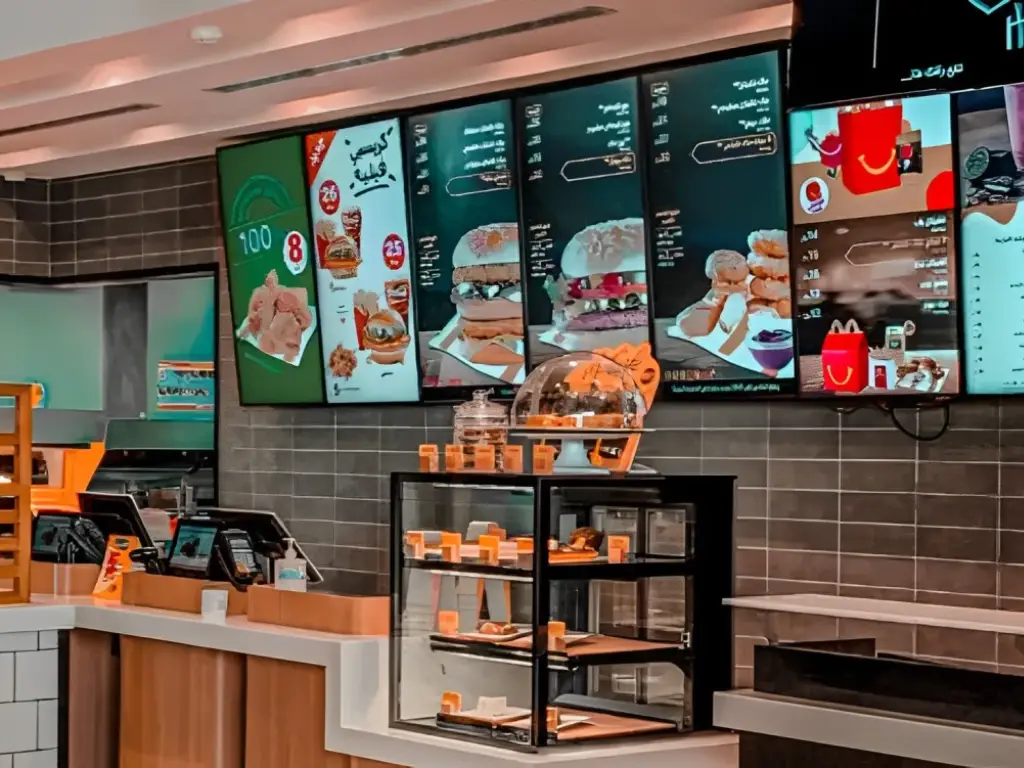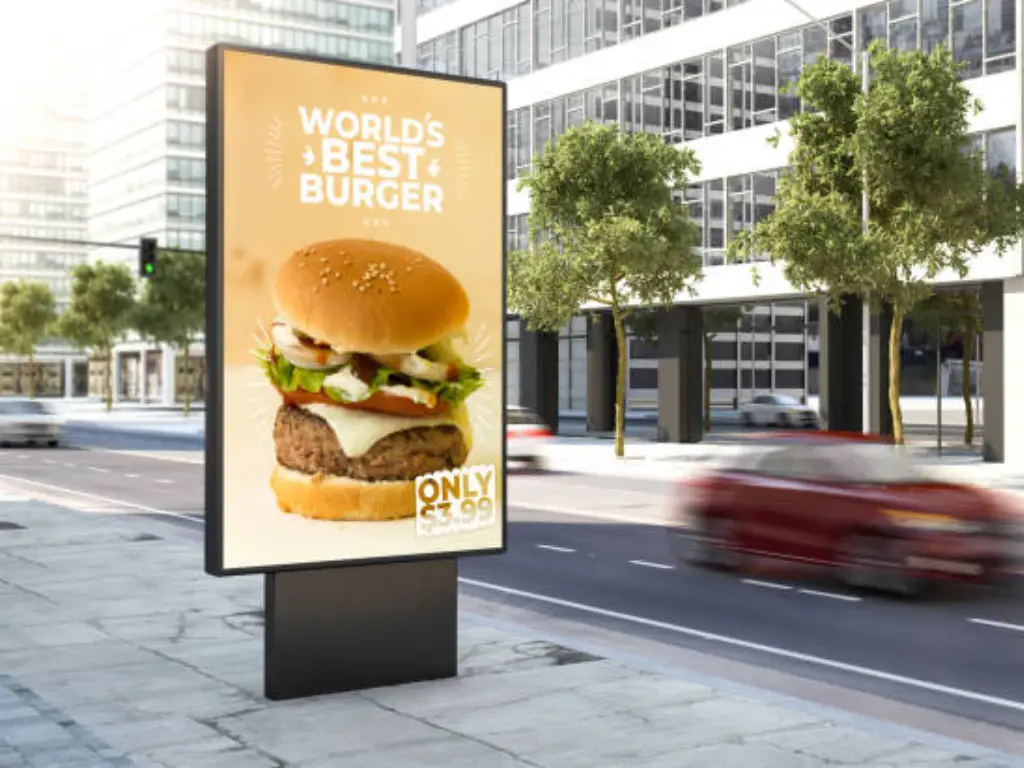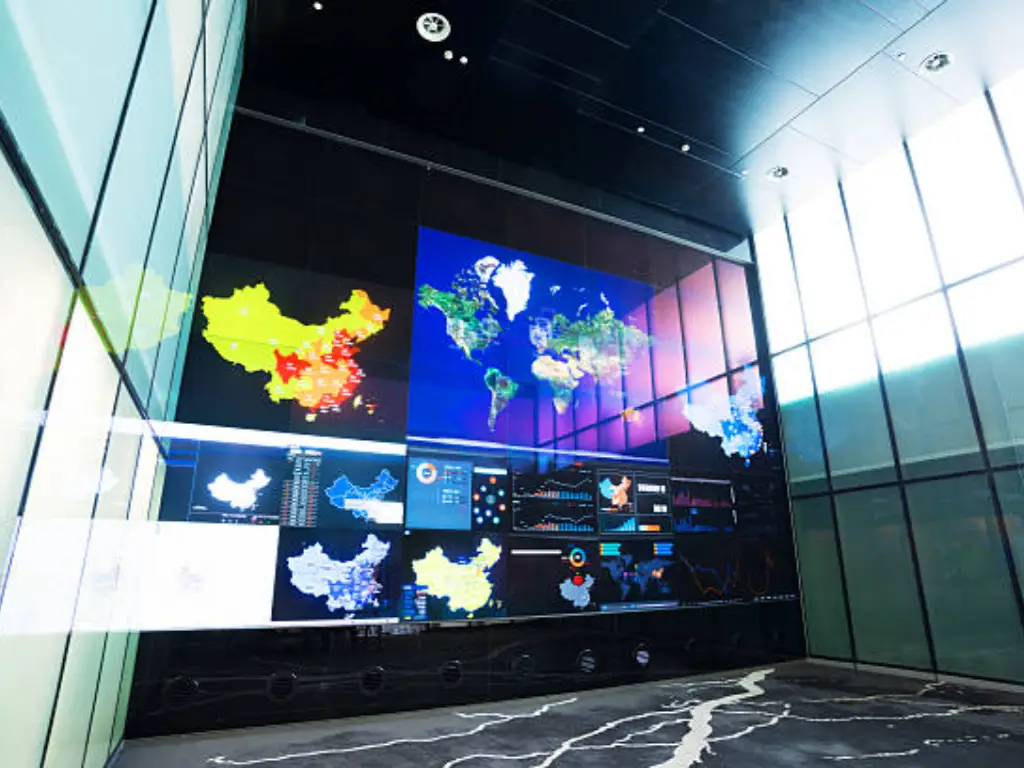What Is Digital Signage and Why It Matters in 2025
Digital signage is a phenomenon that implies the application of digital screens, LED walls, and projectors to convey information, promote products, and participate in the delivery of real-time information. Digital signage is a tool that is becoming a necessity in businesses in all industries as we move into the year 2025. Digital signage is transforming the manner in which businesses engage clients, both in retail spaces, shopping malls, transportation centers, as well as in outdoor settings, and offers dynamic content that captures the attention and engages audiences in a better way than traditional signage.
The digital signage market has been expanding. It is projected by Global Market Insights that the market has an annual compounded growth rate (CAGR) of 8.5, as it was estimated to reach USD 22 billion in 2024, and is projected to reach USD 49.4 billion by 2034. This development highlights the fact that digital signage is not a fad anymore; it is an essential component of business strategy that provides tremendous opportunities to companies to address the audience in new and effective ways.
With the progress of digital signage technology, nowadays businesses can find numerous solutions that can fit various needs and backgrounds. Interactive digital signage in a retail situation, large event video walls, and all types of digital signage have their own use. This paper will discuss 10 major forms of digital signage and how they can make your business communication, customer engagement, and experiences more compelling. These cover all the digital posters and mobile digital signage, which are all specific to the business objectives and the environments.
Types of Digital Signage: A Practical Guide
When deciding on the appropriate digital signage solution to use in your business, it is necessary to look at the use case, the advantages, and the befitting environments. The following is a comparison of the 10 types of digital signage using these pragmatics.
| Type of Digital Signage | Use Case | Key Benefits | Best Environment |
| 1. Digital Posters | Product promotions, event updates | Simple, cost-effective, easy to update, eye-catching | Retail stores, public spaces, transportation hubs |
| 2. Digital Menu Boards | Menus, promotions, order updates | Real-time content changes reduce printing costs | Restaurants, cafes, fast-food chains |
| 3. Interactive Digital Signage | Customer engagement, product exploration | Personalized experiences, increased customer involvement | Retail, trade shows, exhibitions, malls |
| 4. Video Walls | Large-scale advertising, immersive experiences | High visual impact, customizable content across panels | Malls, stadiums, airports, trade shows |
| 5. Digital Billboards | Outdoor advertising, location-based promotions | High visibility, real-time updates, weather-resistant | High-traffic outdoor areas, highways, and city centers |
| 6.LCD & LED Displays | Product promotions, real-time info, interactive experiences | Clear, eye-catching visuals, flexible for various shapes, energy-efficient | Retail, transportation hubs, public spaces, outdoor settings |
| 7. Mobile Digital Signage | Advertising on-the-go, event promotions | Flexibility, adaptability, and real-time content updates | Outdoor events, trade shows, marketing campaigns |
| 8. Corporate & Internal Communication Displays | Employee updates, internal announcements | Real-time communication improves information flow | Offices, break rooms, company lobbies |
| 9. Wayfinding and Directory Signage | Navigation, location-based information | Interactive, personalized directions, real-time updates | Airports, shopping malls, corporate offices, hospitals |
| 10. Projection-Based & Transparent Displays | Visual storytelling, product displays | Engaging, immersive, creative, space-saving | Museums, retail stores, and entertainment venues |
1. Digital Posters: The Entry Point to Modern Advertising
As the starting point for launching digital displays for a business, digital posters remain an inexpensive and easy-to-use option. These posters are mostly positioned in retail and public areas and are designed to capture moving traffic. The content being displayed encompasses marketing and promotional offers to the public and real-time signage and bulletin news.
What makes digital posters unique is their effectiveness with minimal effort. One large digital screen can present any content, whether it’s still or moving, and can be modified for different times of the day, specials, or seasonal campaigns. They can be stationed in shopping centers and transport terminals, and their saturated colors and high-resolution pictures will catch the public’s eye.
On top of that, digital posters can have interactive elements like QR codes and links to social media, allowing the audience to connect with the content. Turning a simple ad into a conversation tool adds value to the content and increases the likelihood of customers engaging with the product/service.

2. Digital Menu Boards: Elevating Food & Beverage Marketing
The digital menu boards have changed the manner in which food and beverage companies interact with their customers. These interactive screens are used instead of the conventional fixed menus, allowing restaurants, cafes, and fast food chains to present actual updates, special offers, and promotions. In a drive-thru or an overcrowded restaurant, the digital menu boards will provide a better experience to the customers with easy-to-read and easily understandable content that can be easily modified to fit the setting.
Digital menu boards enable companies to refresh the content in real-time, and such has been important in the food industry, where time is an important factor. Restaurants are able to replace specials, advertise new products, or even show nutritional data on the fly, and this enhances efficiency and reacts fast to customer demand.
Moreover, digital menu boards are energy-saving and weatherproof, and thus can be used wherever they are, whether indoors or outdoors. They can withstand direct sunlight, extreme temperatures, and other environmental conditions and thus cannot be subjected to damage over time, and can perform similarly in different locations.

3. Interactive Digital Signage: Engage, Educate, and Convert
With businesses looking for novel ways to engage their clientele, interactive digital signage has become one of the most sought-after types of signage. These displays are designed for users to interact directly with content, and their immersive capabilities are unparalleled. Customers can engage with information, products, and services through touch, movement, or even by scanning a QR code, and do it at their own pace.
In the retail stores, interactive displays can be used as virtual assistants, since they can direct customers to the appropriate product, display promotions, or even give out personalized recommendations depending on the inputs provided by the customers. This type of interactive experience not only draws attention but also creates an idea of involvement, hence more likely to become a paying customer.
Besides, these displays can also educate customers on products or services, providing more detailed information and visual references in a manner that traditional signage can never do. The opportunities are unlimited, whether it is through the digital signage content presenting new products or educational videos of what values or processes a company has. And dynamic content means that such displays are continually updated so that their message is always new and up-to-date.

4. Video Walls: Command Attention on a Massive Scale
Video walls can be used where the message is meant to be powerful and displayed in a large area, such as shopping malls, trade shows, or transportation hubs. Comprising several screens combined together to create a huge display, video walls have the potential to display high-definition videos, promotional materials, and even live social media feeds, attracting huge crowds with ease.
The immersive techniques video walls use to create attention-drawing experiences are limitless. A retail store could use a video wall to display its collection in a stunning visual format, or a museum could design a captivating interactive learning experience. There is a level of impact and immersion that only video walls can achieve, which smaller displays simply cannot replicate.
Lastly, video walls provide limitless creative possibilities as they permit different content on each display panel, or they can integrate videos, advertisements, and real-time information into one cohesive stream. This, coupled with the endless possibilities in design, makes video walls a vital resource for advertisers and content creators.
5. Digital Billboards: Dominating Outdoor Advertising
Digital billboards are an important type of outdoor advertisement. It is capable of displaying large ads by acquiring large outdoor spaces in high-visibility locations such as freeways, downtown areas, large venues, and event arenas. Billboards are large captures of attention and are designed to have colorful and high-definition images. Due to their impact, they are a favoured type of advertisement.
Advertising flexibility is especially important in outdoor advertising, and digital billboards provide this by remote access and edits to the advertisement. This real-time manipulation of advertisement helps marketers to make quick changes to signage to accommodate trending products, current events, and the current and changing weather conditions. For example, a weather-triggered advertisement change can be for outdoor and summer clothing.
Digital billboards make it possible to adjust advertisements for different times of the day. Targeted outdoor advertising can be easily customized for local events, and the advertisement can be adjusted for different audience behaviors. These additions make the digital billboard an effective marketing strategy for outdoor advertising.

6. LCD & LED Displays: Versatile and Efficient Digital Signage Solutions
Both LCD and LED displays are candidates to be used as digital signage; they are both high resolution, bright in color, and resilient. The LCD displays are based on the liquid crystal technology and conventional fluorescent back-lighting, whereas the LED displays are based on the LED back-lighting, which is more energy efficient and has a smaller form factor. Both of them offer high-quality images and are clear enough to be displayed in a variety of locations, including retail areas and transit areas.
The difference flower of the LED displays is that they have higher energy efficiency and brightness, which are ideal in large-scale outdoor advertising. LCD displays, conversely, are convenient and less expensive in indoor use, e.g., retail displays or public displays. The two technologies are flexible in shape, as they can be square, circular, or bar-shaped, so that the businesses can select the technology that fits their needs.
Both LCD and LED displays are very versatile, both indoors and outdoors, with the possibilities of being used to display product promotions, live information, and interaction. They can enable business organizations to interact with their customers and promote their brands in large environments due to their capability to portray dynamic content.
Save 10%, Sell Smarter
Transform your store with advanced ESL, E-ink, and LCD displays that boost efficiency and customer engagement.
12+ Years of Experience: Trusted by 41,500+ stores in 180+ countries.
Innovative Technology: AI-driven pricing and real-time updates to enhance your retail operations.
Quality Assurance: ISO 9001 certified, with advanced testing and defect rates under 0.0018%.
7. Mobile Digital Signage: Marketing on the Move
Mobile digital signage provides a special mode through which a business can advertise and communicate with its potential customers as they go. Let it be in a car, a trade show, or an event, the mobile displays enable businesses to carry their marketing messages to new destinations and even to meet diverse audiences at their level. Such digital signage can be particularly applied when it is necessary to draw particular audiences in busy zones or outdoor shows.
Mobility enhances customer interaction. Digital signage players that are designed for the outdoors can be fixed on vehicles, be it a truck, bike, or car. For example, trucks with advertising can also be moved to a desired location. Mobile players designed for the outdoors can also be used to promote advertising on the go. Mobile digital signage can be used to promote special offers that are time-sensitive and location-specific. Companies can change advertising on the go according to the audience and the location. Mobile digital signage allows for personalized customer interaction through an unstaffed remote.

8. Corporate & Internal Communication Displays
Digital signage provides an innovative approach to internal communications. Corporate and internal communication displays help organizations keep employees informed about the latest company news, updates, and live performance metrics. These displays are kept in areas like break rooms, lobbies, and other common areas, making sure everyone can access important information when they need to.
For example, companies can communicate updates about happenings in the company, and even real-time employee performance metrics and achievements. For those organizations that work in the safety-critical industries, digital signage can convey important health and safety information that employees need to always have access to.
Perhaps the biggest value of corporate digital signage is improved communication. Businesses can schedule information and even have it sent to particular displays to ensure that the information is current and that they have avoided the hassle of childish, manual updates.

9. Wayfinding and Directory Signage: Smarter Navigation for Visitors
Wayfinding and directory signage assist visitors in finding their way to the most complex areas, such as shopping malls, airports, hospitals, or corporate offices. These online indicators give easy-to-understand interactive maps and route guidance that enable customers to locate places, the fastest routes, and real-time updates on which roads are facing delays or construction.
The main benefit of the interactive wayfinding is the possibility of providing a personal experience. The system allows visitors to enter their destination, and the system immediately creates customized directions to the destination to save time and confusion. Also, the relevant real-time information that can be displayed on these screens is the ability to have information such as the amenities or events around the user, which improves the user experience.
Digital wayfinding signage may also be updated remotely, and in this manner, a business may hastily update content to mirror alterations, including new building structures or temporary shutdowns. This makes the signage accurate and efficient, which assists in ensuring there is a smooth and pleasant experience of the visitor.

10. Projection-Based and Transparent Displays: The Future of Visual Storytelling
The digital signage is being redefined through projection-based and transparent displays. Projection screens will transform nearly any surface: walls, floors, or windows into touchable signage to produce immersive experiences that engage audiences in new and innovative ways. Basing the digital content on the real world can truly interest customers in a manner that businesses have not managed to achieve before.
Transparent displays, on the other hand, enable digital content to be seen on transparent glass or acrylic surfaces without obstructing the content behind. This allows infinite possibilities of experience that are visual and interactive. Retailers are able to present items in a new perspective, whereas museums or galleries can project digital content onto displays to provide depth and context.
These technologies combine the physical and digital space and provide new possibilities to tell stories, display products, and interact with customers, which traditional signage can’t do. With their development, we may anticipate their increased prevalence in social and business life.

How to Choose the Right Type of Digital Signage for Your Business
Selecting the appropriate type of digital signage is essential to maximize your business investment as well as effectively communicate with customers. Since there’s a wide range of solutions, choosing one can be tricky. That’s why it’s important to highlight a few fundamental considerations to identify the digital signage solutions that will work best for your business in a cost-efficient manner.
- Signage Should Fit Your Business Needs
The first thing to consider is the type of signage that best meets the business’s needs, as well as the physical environment in which it will be used. For instance, retail establishments will typically use digital menu boards and interactive signage, while larger spaces, such as video walls and wayfinding displays, are more commonly used in large spaces like transportation centers.
- Take into Account Foot Traffic and Content Type
While choosing a type of digital signage, factors to focus on are foot traffic, how long the signage will be, and the content type you want to display. If the area is high-traffic, like a shopping mall or an outdoor environment, go for outdoor digital signage like LED screens or digital billboards that can display signage and can withstand outdoor elements. For indoor environments, the customer will be engaged to a greater extent if you use interactive displays or digital posters.
- Assess the Content Management System
The content management system is a key element. The software provides various functionalities for content management, consolidation, and updates over multiple displays. Ensure that you can make remote updates to the system to change messages based on time of day, weather, or specific promotions. Also, make sure that whatever system you purchase can handle the content type you wish to use, whether that be moving images, interactive content, or displaying live data.
- Envisioning Upcoming Digital Signage Solutions
Think about the advancements you might need within digital signage solutions. Since the digital signage technology will continue to develop, your solutions will need to integrate additional capabilities such as interactive signage, QR codes, and mobile displays. Choose digital signage solutions that offer scalability and integration capabilities with other marketing tools to ensure your signage remains relevant as your business evolves.

Emerging Trends in Digital Signage Technology for 2025
As we approach 2025, the advancements in digital signage technology will continue to transform the ways in which businesses interact with their customers. The anticipated developments in this technology are a result of the need for more personalized, engaging, and eco-friendly digital experiences.
- Integration of AI and Machine Learning
As customers monetize signage, businesses will add more AI capabilities that help machines better understand customer behavior and automate sign content. More customers will become satisfied, and content will become more relevant to the customer in real time. The advertising content that customers see will become programmable and adaptive to customer preferences, behaviors, and actions.
- Growing Importance of Interactive Displays
In today’s marketplace, adopting interactive digital signage is a growing trend. Businesses are starting to implement interactive displays that let customers personalize their own experiences. These displays can be hands-on, eliminating the need for static signage, through the use of touchscreens, motion detectors, and even voice controls. For retail, the enhancement of customer experiences through virtual try-ons and tailored suggestions is becoming the industry standard. In the industry, innovations in interactive customer engagement are no longer optional but are actively integrated in improving cx in the industry.
- Focus on Sustainability
In digital signage, the practice of integrating environmentally sustainable approaches has been a growing trend. Business use of energy-efficient products, such as LED and OLED displays, has resulted in positive environmental and sustainable impacts. These products produce more vivid and bright visuals, which help to capture and hold customer attention while simultaneously reducing energy consumption overall. For businesses concerned with the reduction of their operational costs and environmental impacts, energy-efficient signage solutions are available. Implementing energy-efficient digital signage will result in overall positive environmental impacts.
- Rise of Augmented Reality (AR) and Virtual Reality (VR)
To finish, in combination with holograms, AR and VR technology have begun to have an impact on digital advertising. AR and VR have the potential to merge the real and digital worlds, allowing for the construction of experiences of the highest level to preoccupy a customer’s attention. This is particularly the case in the entertainment, retail, and hospitality industries, where experiences must be memorable and interactive. With VR and AR digital advertising, businesses offer clients an experience to remember, and to the competition, the business becomes a target to beat.

Frequently Asked Questions (FAQ)
What Are the Different Types of Digital Signage?
Different types of digital signage include, but are not limited to, indoor and outdoor digital displays, interactive digital signage, and automated digital signage. Each type of digital signage can be customized and serve a variety of purposes and industries, such as retail, hospitality, and corporate businesses, which include internal and external communications and customer engagement.
Can you explain the differences between indoor and outdoor digital signage?
Digital signage, which is used indoors, is meant to be used in restricted premises such as retail stores, malls, and offices. It typically employs indoor-optimized displays and does not have to be weatherproofed. On the one hand, outdoor digital signage is constructed to resist the elements. These are built in a manner that they are resistant to weather conditions, bright enough to be seen when it is in direct sunlight, and tough enough to withstand extreme conditions in the outdoor environment.
What Is the Cost of Digital Signage?
Digital signage is provided at a wide range of prices depending on the type, size, and complexity of the system. Simple indoor displays can be as cheap as a few hundred dollars, and more interactive kiosks or in-store video walls can cost thousands of dollars. When computing the total cost, consider such factors as hardware, software, content creation, and continuing maintenance.
Final Thoughts
The digital signage has emerged as an important tool in the business world that aims to remain ahead of the curve. Digital signage solutions such as digital posters, interactive displays, and video walls can be implemented to address various business requirements, such as enhancing customer interactions to internal communication. Its contribution to business communication is only expected to increase even in 2025, through the improvement of display technology and the management of content.
The success is in selecting the appropriate type of digital signage and applying it to the best in order to stimulate engagement and conversions. In adopting such transforming technologies, companies can produce powerful, customized experiences that enable them to survive in a world that is becoming more and more fast-paced. You should not wait; you should discover what digital signage can offer today and focus on the next stage of your business communication.

